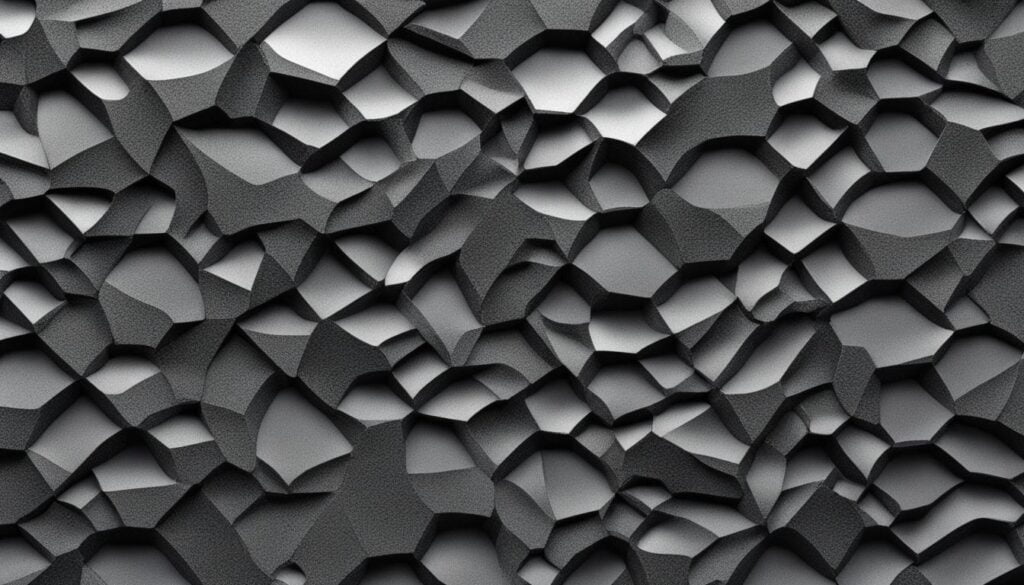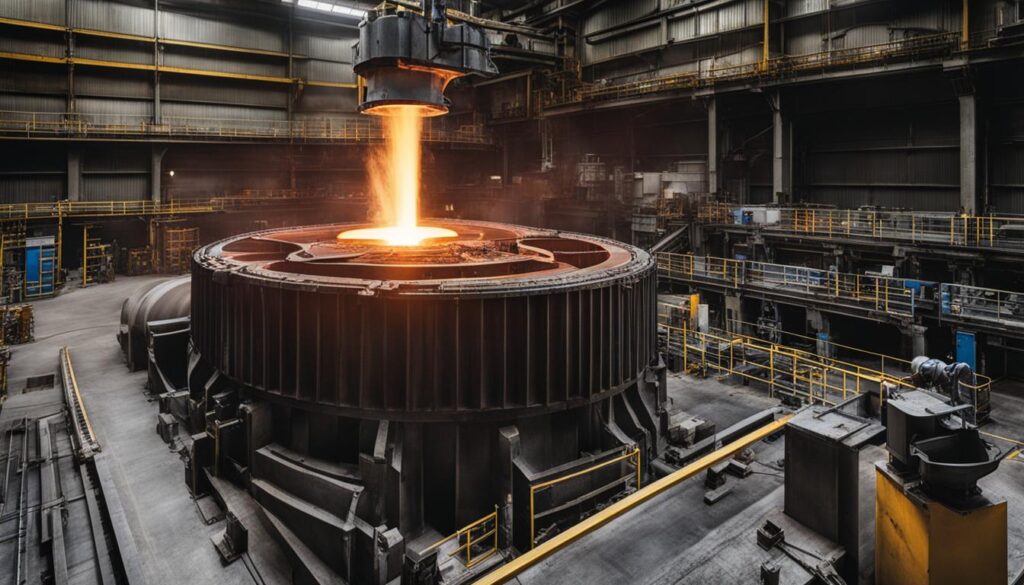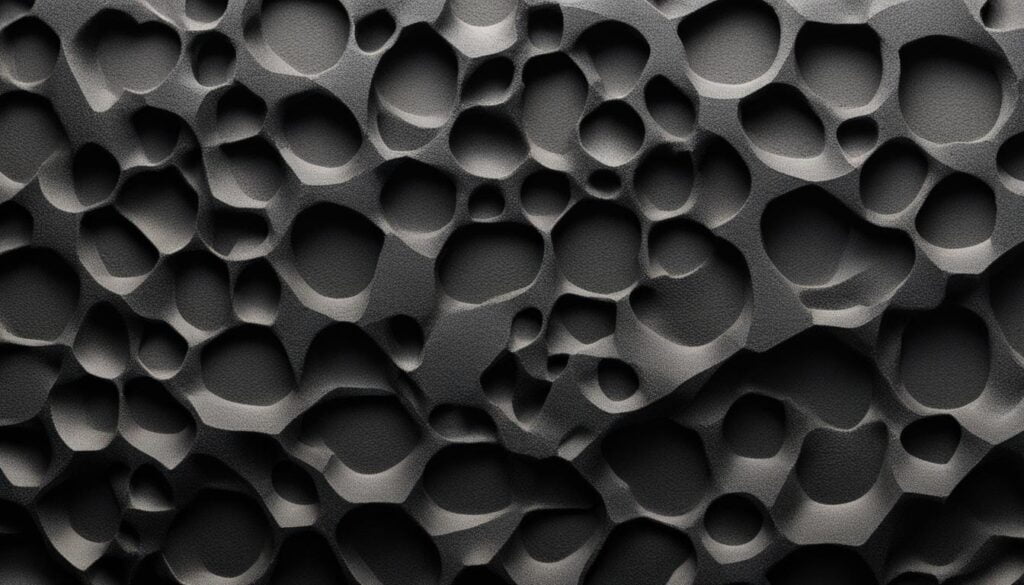Within the walls of our foundry, we pride ourselves on the exceptional quality of our gray iron castings, a staple in the fabrication of essential industrial components. Central to our manufacturing prowess is the intricate graphite microstructure that sets gray iron apart—an engineering marvel recognized for its distinctive ability to thwart the spread of crack propagation. By ingeniously incorporating graphitic flakes within the iron matrix, we ensure that each casting can endure the rigors of its purpose, whether it resides in the heart of an engine or forms the backbone of pumping systems.
The success of gray iron lies in the subtle hues of its namesake color, a testament to the presence of graphite fractures that graciously handle stress, diverting and spawning new cracks elsewhere upon the material’s breach. This unique quality renders our castings indispensable for elaborate machinery parts such as engine cylinder blocks, pump housings, and valves. Our commitment at KT-Foundry stretches beyond mere production; it’s about crafting materials that embody machinability, vibration mitigation, and superior thermal conductivity—all thanks to a precise alloy mix dominated by carbon and silicon.
Key Takeaways
- The graphite microstructure in gray iron castings provides exceptional resistance to crack growth.
- Integral for manufacturing robust industrial components where durability and performance are paramount.
- Composed of an optimal alloy mixture, gray iron demonstrates outstanding machinability and thermal management.
- Graphitic flakes within the iron matrix are key to the material’s ability to dampen vibrations effectively.
- Our expertise ensures the perfect balance of carbon and silicon to achieve the ideal graphite microstructure.
- Gray iron castings are the most commonly used cast material in the industry, valued for their inherent material properties.
Understanding the Graphite Flake Microstructure of Gray Iron Castings
At KT-Foundry, our in-depth analysis of gray iron castings reveals a fascinating interplay between their graphite flake microstructure and the material’s overall mechanical properties. We recognize that this distinctive microstructure plays a pivotal role in our casting’s performance, particularly in how it addresses crack deflection The inherent attributes of gray iron castings are largely due to the form and distribution of graphite within the iron matrix, which, in turn, presents a stark contrast to their ductile iron counterparts.
The inherent attributes of gray iron castings are largely due to the form and distribution of graphite within the iron matrix, which, in turn, presents a stark contrast to their ductile iron counterparts.
Role of Graphite Flakes in Crack Deflection and Fracture
Graphite flakes within gray iron serve as efficient stress relievers during the casting process, allowing for controlled crack deflection. This microstructural phenomenon is crucial in the material’s shock absorption capability. These flakes effectively intercept stress lines and promote the initiation of numerous micro-cracks, rather than allowing the formation of a single, catastrophic crack. This process contributes to gray iron’s ability to perform reliably in applications where sudden or uneven stresses are encountered.
Implications of Flaked Graphite on Mechanical Properties
The presence of flaked graphite in gray iron significantly influences its mechanical properties, imparting a blend of rigidity and compressive strength while limiting tensile strength. As a result of this graphite formation, our gray iron castings exhibit a unique combination of hardness and wear resistance, attributes measured by both Ultimate Tensile Strength (UTS) and Brinell Hardness Number (BHN). Our dedication to optimizing these properties ensures the production of components that meet stringent industrial requirements.
The Contrast Between Gray and Ductile Iron Microstructures
In comparison to gray iron, ductile iron features a radically different graphite structure, where spheroidal graphite nodules provide enhanced ductility and impact resistance. This contrast in graphite shape—flakes in gray iron versus nodules in ductile iron—brings about a substantial difference in their behavior under stress. Whereas ductile iron can withstand substantial deformation, gray iron, with its flaked graphite structure, offers superior resistance to vibrational stresses and better sound dampening qualities, making it the preferred choice for certain engineering applications.
Machinability and Manufacturing Benefits of Gray Iron Castings
At KT-Foundry, our proficiency in industrial components manufacturing allows us to leverage the superior machinability of gray iron castings. The discontinuities in the iron matrix, due to the graphite flake structure, along with the manganese sulfide inclusions acting as lubricants, significantly diminish cutting forces. This, in turn, translates into prolonged tool life and the ability to use lower quantities of metalworking fluids, reducing operational costs and environmental impact.

Even though our gray iron castings provide a wealth of benefits, we are compelled to acknowledge that the advent of high-strength alloyed gray irons has introduced fresh machining challenges. Nonetheless, the demand for these materials is on the rise, particularly in the automotive sector, where thermal fatigue resistance is of utmost importance. To accommodate this, we have refined our manufacturing processes to improve the aging of metalworking tools and to maintain vigilant monitoring to mitigate performance detractors like tramp oil contamination.
Below is an insightful comparison of traditional gray iron castings against high-strength alloyed gray iron castings:
| Aspect | Traditional Gray Iron Castings | High-Strength Alloyed Gray Iron Castings |
|---|---|---|
| Machinability | Excellent due to graphite structure | Challenging, requires enhanced processing |
| Lifecycle of Tools | Extended | Varies; often necessitates stronger tools |
| Use of Metalworking Fluids | Lower amounts needed | Optimized fluids for challenging alloys |
| Demand | Consistently high in various industries | Growing in sectors where durability is crucial |
Thus, at KT-Foundry, while we celebrate the traditional advantages of gray iron castings, we also embrace the evolution within the realm of superior machinability and committedly refine our practices for the future of industrial components manufacturing.
Chemical Composition and Metallurgical Factors in Gray Iron
At KT-Foundry, our profound understanding of gray iron extends to the critical influence of its chemical composition and underlying metallurgical factors. These aspects play a pivotal role in forging the robust graphitic microstructures that define the performance of industrial components crafted from this material.
Role of Carbon and Silicon
Central to our metallurgical practice is the mastery over the proportional balance of carbon and silicon. Carbon, the lifeblood of gray iron’s structure, when coupled with silicon, promotes the formation of graphite. Silicon, specifically, acts as a crucial graphitizing agent, tipping the scales towards graphite creation rather than carbide during the cooling of our castings.
Formation of Graphitic Microstructures
The collaboration of these elements culminates in the formation of the characteristic flake-like graphitic microstructures. It is the delicate choreography of silicon’s presence with carbon that sanctions the evolution of these structures, providing the castings with measurable strength, and the ability to withstand both thermal and mechanical stress.
Influence of Cooling Rates on Graphite Formation
Our expertise in metallurgy further delves into the manipulation of cooling rates to steer the microstructural outcome. We adeptly manage the rate of solidification to ensure optimal graphite distribution, aware that slow cooling nurtures a rich graphitic presence, while swift cooling may prevent its full expression, risking the emergence of white iron with brittle characteristics.
By attentively controlling these metallurgical variables, we guarantee a product that not only exemplifies the integrity of gray iron but also meets the multifaceted demands of our clients’ applications.
Gray Iron Castings in Industrial Applications
At KT-Foundry, we harness the diverse advantages of gray iron castings, leading to their widespread use across various industries. Acknowledged for excellent thermal conductivity and vibration dampening, these castings are integral to numerous industrial components. Their thermal capacity, in particular, makes them indispensable in applications that involve extreme and regular temperature fluctuations.
Typical Uses of Gray Iron in Various Industries
Gray iron’s reputation for durability and performance has led to its adoption in a myriad of sectors. From the automotive industry, where it is used for making brake rotors and engine cylinder heads, to construction, where it serves as a framework for machinery bases, gray iron is the material of choice.
- Automotive parts such as engine blocks and brake rotors
- Heavy machinery and agricultural equipment bases
- Infrastructure components like pipes and manhole covers
- Electric motor housings and counterweights
Advantages of Gray Iron for Specific Applications
The inherent properties of gray iron make it particularly suited for applications that require a balance of strength, thermal management, and cost-effectiveness. Its ability to dampen vibrations, for example, makes it the preferred material for equipment base castings, which face continuous mechanical stresses.
| Property | Advantage |
|---|---|
| Thermal Conductivity | Enables effective heat dissipation in engine parts, preventing warping and failure due to thermal fatigue. |
| Vibration Dampening | Essential for machinery stability, reducing wear and tear and enhancing the longevity of the components. |
| Structural Stiffness | Offers excellent rigidity for large, heavy-duty parts that need to maintain their shape under stress without the need for tensile strength. |
The practical application of these attributes means that components made from gray iron are not only efficient and reliable but also often more affordable due to the lower cost of materials and processing. At KT-Foundry, we take pride in our ability to deliver such economically and functionally superior gray iron castings to our clients.
Conclusion
Our journey through the intricacies of gray iron castings reaches its culmination, reflecting a comprehensive tableau of the vital role played by the graphite structure. At KT-Foundry, our extensive expertise shines through our unwavering commitment to quality and performance in the manufacturing of these industrial staples. The graphite flake microstructure, a hallmark of our castings, enables us to deliver products that exhibit unmatched machinability and superior thermal management capabilities.
The manifold benefits of the graphite structure within gray iron castings are no accident but the result of meticulously balancing chemical composition and metallurgical factors. This balance ensures that each casting from our foundry is poised to meet the highest standards of durability and functionality. Our proficiency is particularly evident in the way the graphite microstructure contributes decisively to a component’s resistance to wear, while enhancing its ability to dissipate vibrations and retain structural integrity under thermal stress.
As industries evolve and the demands for high-quality components rise, we at KT-Foundry are dedicated to leading the charge with our rich tapestry of knowledge and innovative approaches to gray iron casting fabrication. We stand proud of our KT-Foundry expertise, ever eager to forge industrial solutions that exploit every facet of the graphite structure benefits. In aligning with the technological forefront, our team is resolved to ensure that clients across various sectors receive only the most exceptional gray iron casting products available on the market.
FAQ
What is the significance of the graphite microstructure in gray iron castings?
The graphite microstructure in gray iron castings is crucial because it gives the material its excellent machinability, vibration dampening, and thermal conductivity. These features make it ideal for a wide range of industrial components.
How do graphite flakes in gray iron contribute to crack deflection and fracture resistance?
Graphite flakes in gray iron act as stress risers to deflect and distribute the stress around the flake, reducing the risk of fracture and increasing the material’s ability to withstand cracking under tension.
What are the key distinctions in mechanical properties caused by graphite flake microstructure?
The graphite flake microstructure results in lower tensile strength and limited ductility compared to other forms of cast iron. This enhances the material’s ability to absorb and dissipate energy, which is beneficial in applications where vibration dampening is required.
Can you explain the difference between gray and ductile iron microstructures?
Gray iron contains graphite flakes, while ductile iron has spheroid-shaped graphite nodules. This difference gives ductile iron better ductility and impact resistance compared to gray iron, which is more brittle but better at dampening vibrations.
Why is the machinability of gray iron castings superior to other metals?
Due to the graphite flakes within the gray iron creating discontinuities in the metal matrix and the presence of manganese sulfide inclusions, which act as lubricants during machining, the material reduces cutting forces and extends the lifespan of cutting tools.
What is the role of carbon and silicon in the chemical composition of gray iron?
Carbon and silicon are the primary elements in gray iron that promote the formation of graphite flakes during solidification. Silicon, particularly, influences carbon to form graphite and not carbides, which is essential for achieving the desired properties in the final casting.
How does the formation of graphitic microstructures occur in gray iron?
Graphitic microstructures form when the molten iron cools and solidifies. The presence of silicon in the alloy encourages the carbon in the molten iron to form graphite instead of iron carbides.
What is the impact of cooling rates on graphite formation in gray iron?
Cooling rates directly affect the formation and size of graphite flakes in gray iron. Slower cooling rates allow for larger graphite flakes, which contribute to the material’s characteristic properties, while rapid cooling can prevent graphite formation and lead to the development of white iron.
What are some typical industrial applications of gray iron castings?
Gray iron castings are used in a variety of industrial applications, including engine cylinder blocks, pump housings, valve bodies, brake rotors, machinery bases, and decorative elements, due to their ability to withstand thermal cycling and dissipate heat and vibrations effectively.
How does gray iron’s vibration dampening and thermal conductivity benefit specific applications?
Gray iron’s ability to dampen vibrations makes it suitable for machinery bases and other components where stability is crucial. Its high thermal conductivity allows for efficient heat dissipation, which is particularly advantageous for automotive brakes and engines that experience frequent temperature changes.


